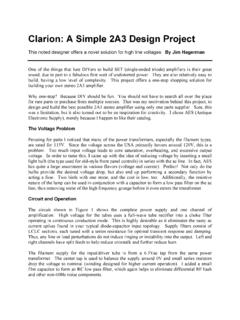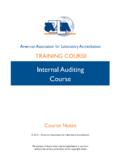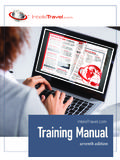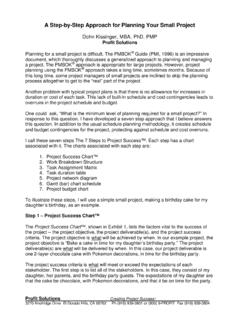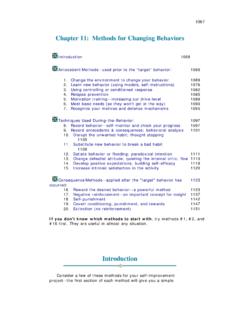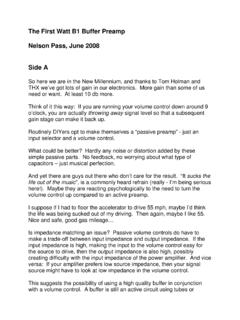Transcription of how to calculate Overall Equipment Effectiveness …
1 E-book: World-Class TPM - How to calculate Overall Equipment Effectiveness (OEE) January 2009 Copyright: Carlo Scodanibbio 2008/09 All rights reserved A simple copyright statement: you are authorised to install this e-course in one computer station only. You are authorised to print this entire course and copy it for exclusive use by employees of your Organisation. You are not authorised to distribute this e-course - by electronic or other means and supports - outside your Organisation. WWoorrlldd--CCllaassss TTPPMM TToottaall PPrroodduuccttiivvee MMaaiinntteennaannccee hhooww ttoo ccaallccuullaattee OOvveerraallll EEqquuiippmmeenntt EEffffeeccttiivveenneessss ((OOEEEE)) CCaarrlloo SSccooddaanniibbbbiioo pprreesseennttss:: Key-words.
2 E-course distance learning e-learning course training education continuing lean maintenance total productive tpm Overall Equipment Effectiveness oee 6 six big losses Equipment plant machinery performance quality operativity rate manufacturing continuous process construction available active operating time breakdown adjustment set-up change over idling minor stoppage reduced speed start-up yield quality defectiveness downtime 2 How to calculate Overall Equipment Effectiveness (OEE) Table of Contents Intro TPM basics Traditional TPM and today s TPM 3 Efficiency, Effectiveness 5 Equipment -related Losses: the 6 Big Losses 6 Losses and Losses Time 9 OEE: Overall Equipment Effectiveness definition 12 General step-by-step method for calculating the OEE index.
3 Machinery Class A 12 Activity Rate 13 Operativity Rate 13 Net Operating Rate 14 Operating Speed Coefficient 15 Performance Rate 16 Quality Rate 17 OEE formula 19 OEE Calculation Sheet 20 General step-by-step method for calculating the OEE index: Machinery Class B 23 Activity Rate 23 Operativity Rate 23 Net Operating Rate 24 Operating Speed Coefficient 26 Performance Rate 26 Quality Rate 27 OEE formula 29 OEE Calculation Sheet 30 Equipment Ranking 35 OEE Record Keeping 36 OEE Monitoring Chart 37 OEE Records Analysis Graphs Launching Improvement Actions 38 OEE and 6-Sigma example of OEE analysis 41 Modern OEE developments.
4 Safety Rate & Environment Control Rate 45 Equipment -related Waste 46 Solutions of Exercises 49 Credits 51 Excerpts from Carlo Scodanibbio web site 52 How to calculate Overall Equipment Effectiveness (OEE) 3 Dear e-Participant, Welcome to this e-Course! I am confident you will find it of interest, beneficial and, at times, also a bit entertaining. To begin with, a quick presentation: I am Carlo Scodanibbio, Italian, Engineer, graduated in 1970, and with some 38 years of post-graduate experience in Project Engineering, Plant Engineering, Project Management, Industrial Engineering and Operations Management Consulting.
5 I have been a free-lance Industrial Consultant for the past 28 years, and a HR Trainer for the past 18. My field of activity is: World Class Performance in the Small and Medium Enterprises. I have operated in several Countries, including Italy, Romania, Malta, Turkey, Cyprus, Lebanon, Cape Verde, Kenya, Mauritius, Malaysia, India, Saudi Arabia, South Africa and neighbouring Countries. My real-world training style is very interactive. I am afraid this won t be possible in the case of an e-Course, such as this one. And yet, as a participant in this e-Course, you are entitled to contact me for clarifications or further explanations with regard to the topics of this Course.
6 You may do so by e-mail: And now let s start. The title of this Course is: How to calculate Overall Equipment Effectiveness (OEE) This is a primary-importance topic in the Total Productive Maintenance (TPM) discipline. Before discussing about OEE, let me remind you of some basic principles of TPM. TPM was created originally by Nakajima over 20 years ago, and still considered today the leading Plant Management philosophy. Actually, TPM is one of the pillars supporting any type of world-class Operations, be they Manufacturing, Construction or Service operations (the architectural representation below refers to World Class Manufacturing Operations): How to calculate Overall Equipment Effectiveness (OEE) 4 In the ideal productive process, Equipment should be operating at 100% capacity 100% of the time.
7 TPM is a powerful discipline leading, in a process of continuous, systematic improvement, towards the ideal, with 0 downtime, 0 defects and 0 safety problems. Traditional TPM (as created by Nakajima) is a set of participative programs designed to increase Equipment Effectiveness (productivity - quality - safety) and aiming at various goals: elimination of the 6 big losses, in order to maximise Equipment Effectiveness restoration of Equipment to optimal operating conditions elimination of accelerated deterioration autonomous maintenance activities to maintain basic Equipment conditions increase in efficiency and cost- Effectiveness of maintenance function maintainability improvement and development of a maintenance system for the Equipment life maintenance prevention total involvement of people from all depts.
8 That plan, design, use or maintain Equipment - involvement of top management increase of operation and maintenance skills max. safety and environment conservation/pollution control and others In this course we shall deal only in part with the first goal (elimination of the 6 big losses, in order to maximise Equipment Effectiveness ). Before going into that, let s point out that TPM has developed over the years, and today s TPM is somewhat different from the original concept. How to calculate Overall Equipment Effectiveness (OEE) 5 Modern TPM is primarily concerned with the value generated by Equipment , or by Equipment and people together (as applicable).
9 Today s TPM focuses on the entire productive process to assure that the right Equipment is part of a value-adding/waste-free series of operations, to assure (by deploying traditional TPM approaches) that Equipment contributes effectively to the primary objective of value-generation. As such, a valid TPM program starts with a thorough, critical examination of each productive process, querying the value-adding status of each piece of Equipment (or Equipment and people) in relation to the process. The above illustrates the lean (waste-free) nature of modern TPM.
10 Today s TPM overlaps with and is integral part of a newly-born discipline called Lean Maintenance. Back to Overall Equipment Effectiveness . Firstly, let s introduce the concept of Equipment Efficiency (as distinguished from Effectiveness ): From this definition, one can see that Equipment Efficiency is higher/highest when that piece of Equipment operates under optimal conditions with the minimum possible Life-Cycle Cost (or, Overall Cost of a piece of Equipment throughout its entire life-cycle, including: procurement cost, installation cost, maintenance cost, special tooling and, eventually, disposal cost).

